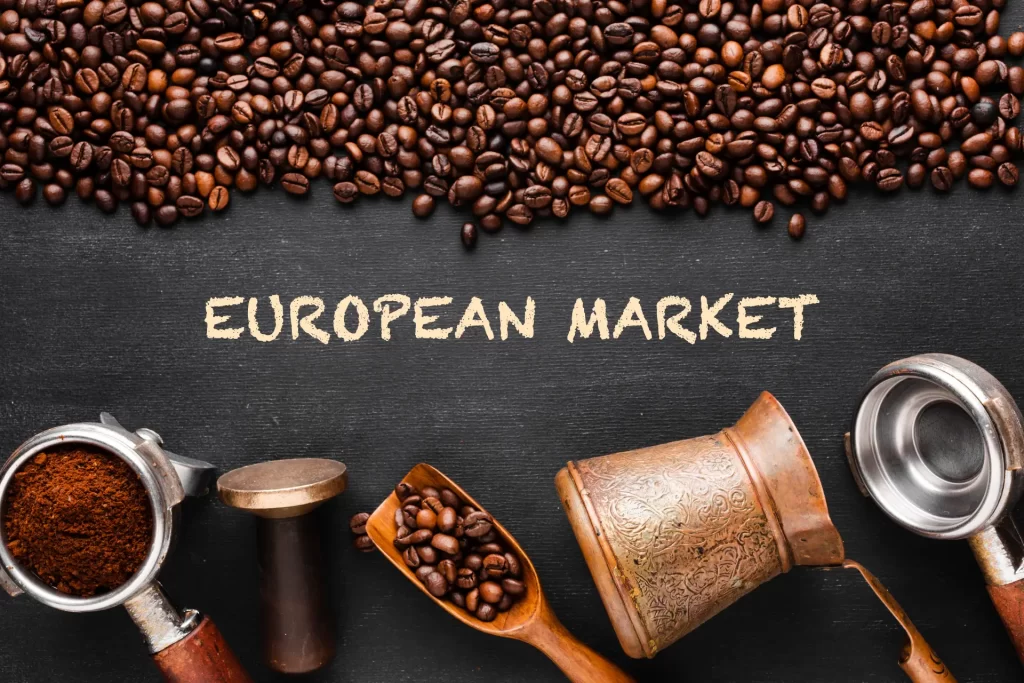European markets offering most opportunities for coffee exporters
Europe offers many opportunities to coffee exporters. The countries that offer the most opportunities show a mix of positive characteristics, including import volumes, of which a large share is sourced directly from producing countries, different suppliers, their role as distributor of green coffee beans and a growing market for specialty coffees. Germany, Italy and Belgium stand out as the most interesting markets for green coffee exporters. But markets such as France, Spain and the United Kingdom are also very attractive. Eastern European markets are smaller and show fewer direct links to producing countries, but are growing fast. Germany is Europe’s all-round most important coffee player Germany is the largest importer of green coffee beans in Europe. In 2020, Germany imported over 1.1 million tonnes of green coffee. Germany accounted for 35% of all European coffee imports sourced directly from producing countries. With 37% of total direct imports, Brazil is the largest supplier of green coffee to Germany, followed by Vietnam (22% of supplies) and Honduras (10%). On average, German green coffee import volumes remained fairly stable in the last years, with a slight decline of -0.7% between 2016 and 2020. Most green coffee beans enter Germany via the Port of Hamburg. The ports of Bremen and Bremerhaven are also important entry points for coffee. As the largest importer in Europe, Germany is a potential destination for exporters of various qualities and origins, which will either be roasted locally or re-exported to other markets. Germany plays a major role in green coffee re-exports in Europe, giving it an important role as a key coffee trade hub in Europe. About 36% of the total EU intra-trade exports were re-exported by Germany alone, amounting to 175 thousand tonnes in 2020. German intra-EU coffee exports increased on average by 1.0% between 2016 and 2020. The main destinations for Germany’s green coffee re-exports in 2020 were Poland (88 thousand tonnes), France (21 thousand tonnes), the Czech Republic (16 thousand tonnes) and the Netherlands (12 thousand tonnes). Germany has the largest coffee-roasting industry in Europe; roasted coffee is both destined for local demand as well as for export. Examples of some large-scale coffee roasters in Germany include Melitta and Tchibo. In 2020, Germany was the second-largest roasted coffee exporter in Europe (after Italy) with exports amounting to 235 thousand tonnes. The main destination markets for roasted coffee were Poland (34 thousand tonnes), the Netherlands (28 thousand tonnes) and France (20 thousand tonnes). German per capita coffee consumption is not among Europe’s highest, but at an average 5.5 kg per year it still sits above the European average of 5 kg. The market for specialty and high-quality coffee in Germany provides especially interesting opportunities for exporters that fit into this segment. Germany has the second-largest branded coffee-shop market in Europe, only after the United Kingdom, while it is Europe’s largest market for shops specifically focused on coffee. Besides, Germany is Europe’s largest market for organic produce, providing interesting opportunities for the export of organic-certified coffees. Note, however, that in Germany you will also find the most competitive organic coffee market in Europe. Italy has a strong coffee-roasting industry Italy is the second-largest importer of green coffee beans in Europe, only surpassed by Germany. In 2020, Italian green coffee bean imports reached a volume of 565 thousand tonnes. Italian imports declined slightly at an average annual rate of -0.3% between 2016 and 2020. About 98% of Italian imports are sourced directly from coffee producing countries. The main suppliers of green coffee to Italy are Brazil (166 thousand tonnes), followed by Vietnam (133 thousand tonnes) and Uganda (76 thousand tonnes). In general, Italy imports a relatively large share of Robusta varieties, which are used as a basis for espresso blends. Green coffee beans are mainly imported into Italy via the Port of Trieste and the Ports of Genoa. Almost all of Italy’s green coffee imports remain in the country and are used by the very strong Italian coffee-roasting industry. Large Italian roasters, such as Lavazza, Segafredo and Illy, export substantial amounts of Italian coffee blends to destinations all over Europe and the United States. This creates an important demand for green coffee from coffee producers worldwide. Italy was Europe’s largest roasted coffee exporter in 2020. Italy’s roasted coffee exports in 2020 amounted to 236 thousand tonnes. The country’s roasted coffee export volumes increased at an average annual rate of 5.0% between 2016 and 2020. Italy is also a large consumer market. Coffee is an integral part of culture in Italy, where each person consumes an average of 5.9 kg of coffee a year. The specialty coffee market in Italy is only slowly taking off, as Italy has only an estimated 100 specialty coffee shops (serving high-quality and unique coffees) compared to almost 150 thousand coffee bars. Despite being a small niche market, the fact that Italy is slowly welcoming more specialised coffee roasters and shops might bring interesting opportunities for high-quality coffees from special origins and with unique stories. Belgium as a trade hub for coffee in Europe Belgium is Europe’s third-largest green coffee importer. It accounted for 10% of all direct green coffee imports in Europe in 2020. A share of 96% of the country’s green coffee imports was sourced directly from producing countries in 2020, amounting to 301 thousand tonnes. Brazil was the largest supplier of green coffee to Belgium, with 84 thousand tonnes in 2020. Vietnam ranked as the second-largest supplier with supplies reaching 61 thousand tonnes, followed by Honduras with 38 thousand tonnes of green coffee. Overall direct green coffee imports by Belgium increased at an average annual rate of 1.0% in volume between 2016 and 2020. Belgium is one of the main trade hubs for coffee in Europe. Over 77% of its imports are re-exported, amounting to 243 thousand tonnes of green coffee re-exports in 2020. This makes Belgium the largest re-exporter of Europe, with a share of 33% of total European green coffee re-exports. The main export destinations of Belgium are its
European markets offering most opportunities for coffee exporters Lire la suite »



